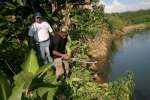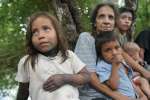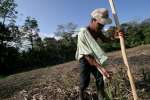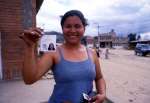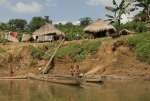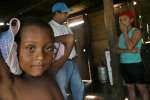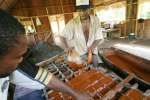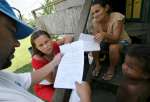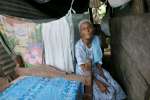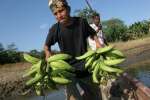Brazil helps ease local integration of refugees in northern Ecuador
News Stories, 17 February 2011
LAGO AGRIO, Ecuador, February 16 (UNHCR) – When a senior Brazilian diplomat visited north-east Ecuador last weekend he saw the first fruits of a unique cooperation programme aimed at easing the local integration of thousands of Colombian refugees.
During a two-day visit to the border province of Sucumbios, Brazilian Ambassador to Ecuador Fernando Simas opened a classroom in the provincial capital, Lago Agrio, inspected new facilities in a shelter for abused women, visited a renovated playground and met refugees in an isolated community on the Putumayo River, which forms the border with Colombia.
Under an agreement with Ecuador signed last September, Brazil pledged to actively support the integration of the estimated 15,000 refugees in Sucumbios and to help their needy Ecuadorean neighbours. It is the first cooperation agreement of its sort in Latin America.
The Brazilian government is funding projects in the areas of education, sexual and gender-based violence, and water and sanitation infrastructure. The UNHCR office in Lago Agrio is organizing their implementation.
"These are flagship projects, the first undertaken with Brazilian cooperation in such remote communities. They benefit both Ecuadoreans and Colombian refugee families," said Ambassador Simas, adding: "This help is given in recognition of Ecuador's commitment to receive these displaced Colombians."
Staff and students at the February 16 Primary School in Lago Agrio gave the envoy a warm welcome when he arrived with UNHCR staff during a thunderstorm to open the new classroom, which was built with Brazilian funds.
"There are many refugee children studying here," said one of the teachers, while adding that they were welcome. "We are very happy today as professional teachers, because, with this new classroom, we will be able to give our best to the children, their parents and the community."
In the town's El Aeropuerto district, Simas was shown public conveniences built with Brazilian funding as well as a rehabilitated playground benefitting all children who live in the area. In the headquarters building of the Sucumbíos Women's Federation he was shown a recreation room for the children of female victims of domestic violence.
During his visit to the isolated riverside community of El Palmar, the ambassador saw another primary school that has benefitted from Brazil's generosity. About 60 per cent of the 80 families in the community are refugees from Colombia, which can be seen across the Putumayo River.
"Until now, the children here had to take their classes in a little hut. This new brick classroom means they can be educated in dignified conditions," said Ines Guerrero, headmistress of El Palmar's La Paz Primary School. The facility, which has almost 100 students, also boasts new, more hygienic washroom facilities.
Luis Varese, UNHCR's deputy representative for Ecuador, welcomed Brazil's "unprecedented" assistance in seeking solutions. "These are the first primary schools to be opened by UNHCR with Brazilian funds in Latin America within a South-South cooperation framework," he said, referring to the facilities in Lago Agrio and El Palmar.
"Within the sphere of regional integration, it is very important for these bonds of cooperation among our nations to take root and for us to make contributions that bring home the message that continental solidarity is indeed possible," Simas concluded.
By Sonia Aguilar in Lago Agrio, Ecuador







